ISSN ONLINE(2278-8875) PRINT (2320-3765)
ISSN ONLINE(2278-8875) PRINT (2320-3765)
Diwakar Singh1, Amit Kumar Gupta2, R.K.Prasad3
|
| Related article at Pubmed, Scholar Google |
Visit for more related articles at International Journal of Advanced Research in Electrical, Electronics and Instrumentation Engineering
This paper presents design and analysis of linear array of two S-shaped Microstrip patch antenna. The design, analysis and simulation of this antenna are performed over IE3D software Ver. 15.2. The dimension of ground plane is taken as 50x70 mm and patch size is taken as 40x60 mm. We have obtained bandwidth in single band – a bandwidth of 63.05% at 1.8844 GHz band and also a gain of 3.67152 dBi at 2.42271 GHz band. The thickness of substrate is taken as 1.6 mm, dielectric constant is taken as 4.2 and loss tangent is taken as 0.0013. Mainly this antenna is designed for wireless applications.
Keywords |
| S-shaped array configuration, Ground plane, patch antenna, single band. |
INTRODUCTION |
| The antenna is broadly classified in two categories – directional antenna and unidirectional antenna. Most of the conventional antennas like yagi uda, helical, horn, parabolic etc are directional. They are quite good in terms of bandwidth and gain. In spite of all these advantages they have some disadvantages also like large volume, very bulky, complex 3d structure etc. Microwave applications require small antenna size so all these antennas are not well suited for microwave applications. Microstrip antenna is the one which is well suited for wireless and microwave applications. This antenna has small volume, low cost, simplified 2d structure. Narrow bandwidth and gain are main disadvantages of this antenna. To overcome these disadvantages various techniques are used like varying the substrate thickness, changing the dielectric value of substrate[4], using the various patch configurations[1],[2],[5], using stack configuration[3] etc.This paper gives an idea of linear array of two S-shaped Microstrip patch antenna to obtain more directional properties. |
RESEARCH METHODOLOGY |
| The research methodology includes design and analysis of linear array of two S-shaped Microstrip patch antenna. In this array configuration two S-shaped patch antennas are used. All antennas are having equal size and also these antennas are well connected to form an array. The final design is simulated over IE3D software to obtain various parameters. The co-axial probe feeding technique is used to feed this antenna. |
ANTENNA DESIGN |
| The linear array includes two S-shapes. Both S-shapes are equal in size. The design is given as - |
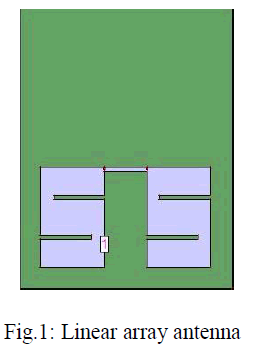 |
RESULTS AND DISCUSSION |
| First of all return loss curve is considered to determine the bandwidth. This curve is given as – |
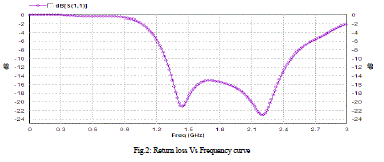 |
| The curve is crossing -10 dB line single time, so we obtain the bandwidth in single band. |
CALCULATION OF BANDWIDTH |
| Next curve shows the VSWR curve to determine the usefulness of bandwidth. The curve is given as – |
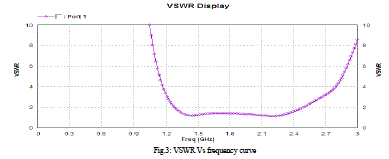 |
| The curve is below 2 for entire frequency range so the obtained bandwidth is useful. |
| Next important curve is gain curve. We obtain a quite good amount of gain which is much helpful for wireless applications. |
| The curve is given below - |
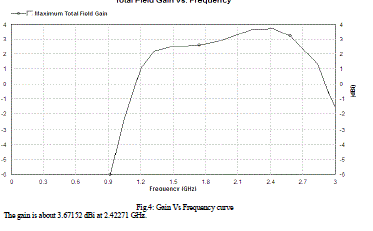 |
| The gain is about 3.67152 dBi at 2.42271 GHz. |
| Next diagram shows the directivity curve which is given below – |
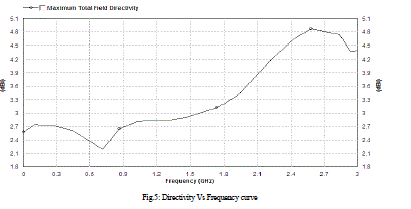 |
| From the figure it is clear that the directivity is 4.85961 dBi at 2.57886 GHz which is quite good for this configuration. |
| Next curve shows the antenna efficiency curve which is shown below – |
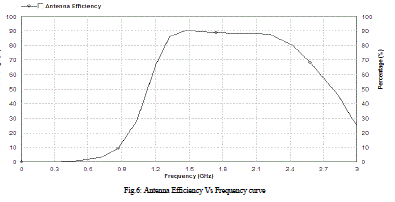 |
| From the figure it is clear that antenna efficiency is 90.3353% at 1.47634 GHz. |
| Following figure gives radiation efficiency curve which is given as – |
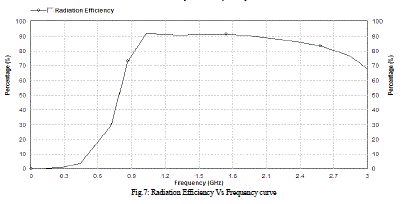 |
| It is shown that the radiation efficiency is 92.0057% at 1.03628 GHz. |
CONCLUSION |
| The linear array of two S-shaped Microstrip patch antenna is designed and simulated over IE3D software Ver.15.2. We have obtained the bandwidth in single band – a bandwidth of 63.05% at 1.884405 GHz, a gain value of 3.67152 dBi at 2.42271 GHz, a directivity of 4.85961 dBi at 2.57886 GHz , antenna efficiency of 90.3353% at 1.47634 GHz and radiation efficiency of 92.0057% at 1.03628 GHz. Many technique of enhancing the gain and bandwidth of Microstrip patch antenna is still in progress. |
ACKNOWLEDGMENT |
| We are highly thankful to department of Electronics and Communication Engineering for giving us valuable support in the research. |
References |
|